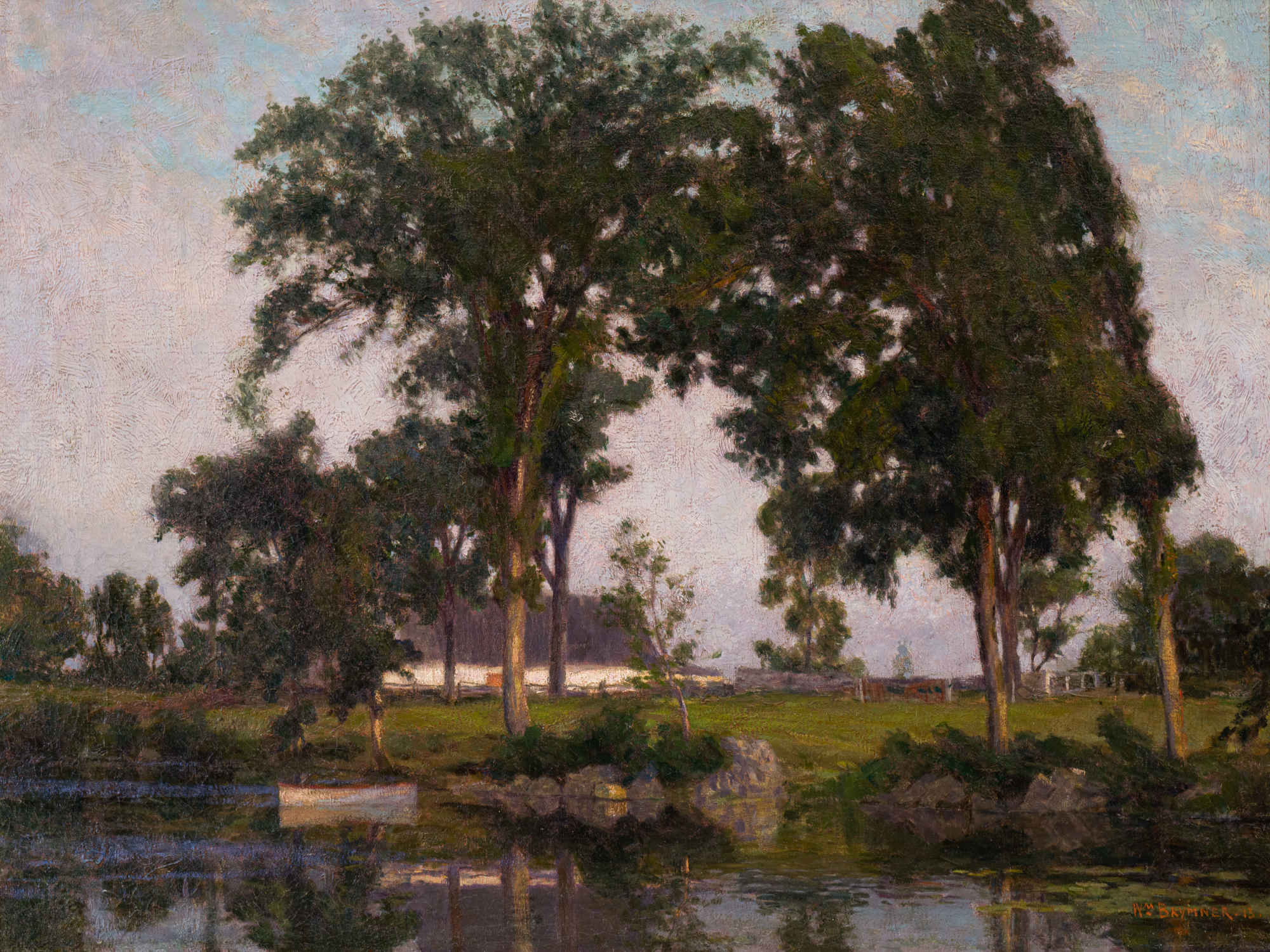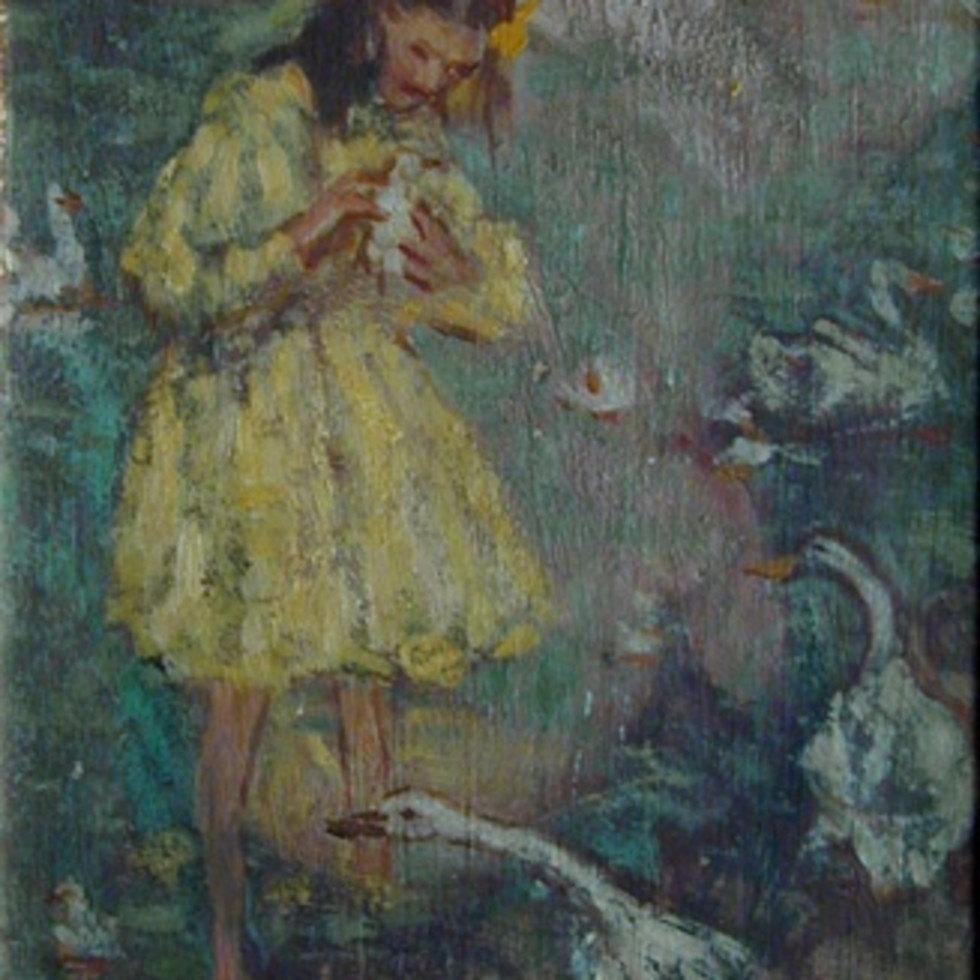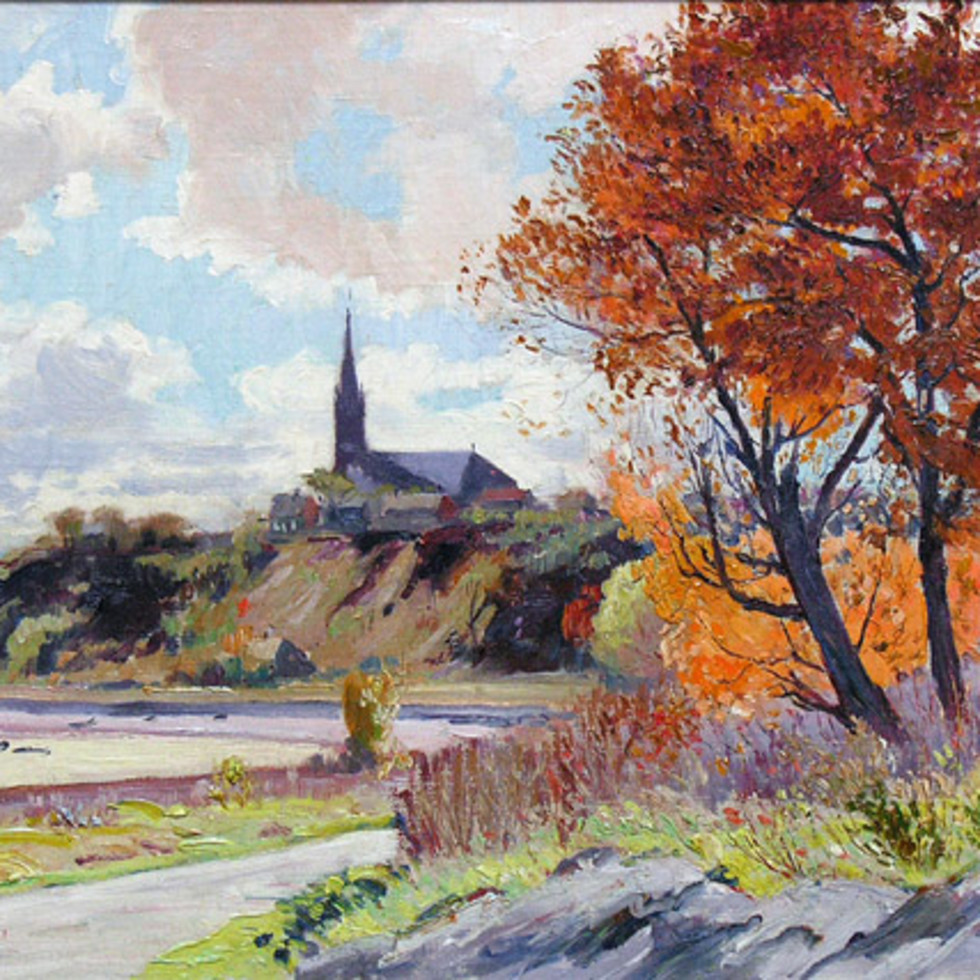Artwork for Sale
Afterglow, 1913
76.5 x 101.8 cm
Inscriptions
signed and dated, ‘Wm BRYMNER .13.’ (lower right)Provenance
William Scott and Sons, Montreal
Dr. W. W. Chipman, Esq., Montreal
Christie’s, British and Continental Pictures, 19 February 2004, lot 196
Private collection, Vancouver
Sotheby's/Ritchies, Important Canadian Art, 28 May 2007, lot 76
Galerie Walter Klinkhoff Inc., Montreal
Property of a Distinguished Montreal Collector
Exhibitions
Toronto, Royal Canadian Academy of Arts, 1913, cat. no. 41.
Toronto, Museum of Toronto, Seventh Annual Exhibition of the Canadian Art Club, 1 - 13 May 1914, cat. no. 7.
Winnipeg, Winnipeg Museum of Fine Arts, Second Annual Exhibition by the Royal Canadian Academy of Arts, January-March 1914, cat. no. 16.Literature
“Art Association Exhibition Shows Notable Advance,” The Star (Montreal), 20 November 1913.
“It is a pleasure to congratulate, first, the President of the Academy, Mr. Brymner himself has sounded a conspicuous note of departure. He shows three pictures, and all three are careful and most interesting studies in light effects. They are ‘Afterglow’ (41), ‘Late Afternoon’ (43), and ‘Nightfall’ (42). They are not all of equal merit, but they are all painted with a poetic feeling which impresses the spectator. In his treatment of the light that falls between the sun's setting and evening, Mr. Brymner has come nearer the truth than in any of his landscapes that I remember to have seen. His brush work is always sure, and his skies are exceptionally good. [...] in ‘Afterglow’ there is just that indefinable suggestion of something mystical, that so often makes itself felt as the sun goes down and the light broadens and deepens in the West. The spirit of peace brooding over the river scene is conveyed with an authority and a power that cannot fail to impress.”
“The Montreal Group”, The Gazette (Montreal), 21 November 1913, p. 5.
“In ‘Afterglow,’ Mr. William Brymner President of the Royal Canadian Academy, has produced the most satisfying of picture in many years. He has caught the spirit of the hour — in a canvas showing admirable constructed and conscientiously painted elms at the edge of a stream. The stems hold the fainest glint of the rosy glow which tones the heavens. A boat moored near the shore, a few rocks and a whitewashed barn also catch the most delicate tone which is not insistent but evenly fills the atmosphere of the picture. There is no apparent effort at appearing clever — it is a poetic interpretation of the quiet hour before dark — A subject which many essay and few accomplish so effectively.”
“The Annual Academy Results in Collection of Very Fine Exhibits,” The Daily Telegraph (Montreal), 21 November 1913.
“The general note of the present display is set by the picture which is given the place of honour in centre wall of the main gallery — a picture entitled ‘Afterglow’ by the president of the institution, Mr. Wm Brymner. It is a picture, in subdued but luscious colors, of trees and meadows, seen in the fleeting beauty of that few moments when the tide of day definitely ebbs towards night. One feels that behind a picture of this kind there is personality and the settled purpose of conscious strength. It lifts one out of the clang and clatter of the daily round, and carries one back to the beauty of dignity and repose of nature. Mr. Brymer’s art has improved wonderfully in recent years. He seems to see in the beauty of nature something largely and more profound — to see in it what Emerson calls 'the herald of inward and eternal beauty.'”
“Montreal Artists Are Well Represented at R.C.A’s Annual Exhibit” The Herald (Montreal), 22 November 1913.
“The president of the academy is splendidly represented by ‘After glow [sic]’ a study of evening light. An admirably painted group of elms by the side of a stream catch the glow from the fading sunset, which fills the whole picture. The restrained manner in which the artist has handled this difficult effect makes the success of what is one of the most notable contributions in recent years to the Academy.”
“To Promote Art in Minor Centres. The President’s Work”, The Gazette (Montreal), 9 December 1913, p.8.
“Mr. William Brymner president of the Academy, presents three landscapes which give to the region about the St. Eustache he subtly captivating charm of late summer and autumn in much fuller measure than in all his previous work of kindred inspiration; yet he has made no sacrifice of his long familiar directness and frankness of treatment. In ‘Afterglow (41)’, the eye dwells with pleasure on the warm roseate tone diffused over the picture and harmonized with the deeper tints of the carefully grouped masses of foliage. To grasp the full value of the lucid atmosphere in this picture, as well as the slightly pink-tinged building with its subdued reflection, a trifle of distance is required by the spectator. The effect in nature delicately rendered here is, it should be remembered, evanescent.”
C.L. Sibley, “The Greatest Show of Canadian Painting”, The Globe (Toronto), 20 December 1913, p. A3.
“Naturally the place of honor in the main gallery is given to the President of the Academy, Mr. William Brymner of Montreal. Mr. Brymer’s art has broadened and mellowed very considerable in recent years. He is at his best in landscapes and all three pictures which he shows on this occasion are country scenes. Their names are suggestive of their character — ‘Afterglow’ [...]. Mr. Bymner has succeeded in each imparting a sense of intimacy and at the same time of elusive mystery. The coloring is lush but low-toned.”
Royal Canadian Academy of Arts, Catalogue of Winnipeg Museum of Fine Arts Second Annual Exhibition by the Royal Canadian Academy of Arts (s.l.: s.n., 1914), 6.
Canadian Art Club, Catalogue of the Canadian Art Club, 1914: Seventh Annual Exhibition (Toronto: Canadian Art Club, 1914), unpaginated [reproduced].
“Montreal” American Art News, Vol. XII, no. 13, 2 January 1914, p. 11.
“Naturally the place of honor in the main gallery is given to the President of the Academy, Mr. William Brymner of Montreal. Mr. Brymer’s art has broadened and mellowed very considerable in recent years. He is at his best in landscapes and all three pictures which he shows on this occasion are country scenes. Their names are suggestive of their character — ‘Afterglow’ [...]. Mr. Bymner has succeeded in each imparting a sense of intimacy and at the same time of elusive mystery. The coloring is lush but low-toned.”
“After Glow” The Globe, 9 May 1914, reproduced, Saturday Magazine Section p. 3.
“Landscapes Shown by the Canadian Art Club” The Globe (Toronto), 2 May 1914, p. 11.
“William Brymner exhibits an evening landscape, which breathes peace and quiet.”
Art of the British Empire Overseas, ed. Charles Holme (London, Paris, New York: “The Studio” Ltd., 1917), 18 [reproduced].
“William Brymner, President of the Canadian Academy, is one of these foremost men [...] he paints the country of old Quebec settlements, and realized much of the old-world sweetness that clings round them. His work is sincere and painstaking: there is no striving after novelty or new colour, but the simple truths of nature’s changing expression are given with a steady of sober earnestness which remains where much superficial brilliance fades.” (p. 4)
Canadian Painters from Paul Kane to Group of Seven, ed. D.W. Buchanan, (Montreal, 1941), plate 12, [reproduced].
Lydia Bouchard, "Les paysages Québécois de William Brymner, expérience de la nature comme lieu identitaire Canadien au tournant Du XXe siècle," master’s thesis, University of Quebec, Montreal, June 2009.
«Par exemple, Afterglow souligne la sérénité et le calme de la tombée du jour [...] La terre, le ciel, la lumière et l'eau sont agencés pour créer des paysages légèrement idéalisés, comportant parfois un rapport dialogique entre le céleste et le terrestre. La nature y est ancienne, prospère, bucolique, paisible, parfois mélancolique mais jamais menaçante. Elle représente un milieu de vie harmonieux pour l'humain dont les traces discrètes sont omniprésentes.» (p. 57) «Ses paysages crépusculaires sont tout en nuances poétiques, comme le remarque les comptes rendus de l'exposition de l'ARAC en 1913, où Brymner soumet trois paysages de fm de jour à Saint-Eustache [...]» (p. 72)
Publications
The McCord-Stewart Museum in Montreal holds a photograph, Landscape, 1913, painting by and copied for William Brymner, copied 1916 (Accession No. VIEW-16078), that is a print of the present canvas. (http://collections.musee-mccord.qc.ca/en/collection/artifacts/VIEW-16078).William Brymner, Afterglow
by Jocelyn Anderson
A tranquil evening landscape, Afterglow captures a stream at dusk. Two tall elm trees at the water’s edge dominate the composition, their stately trunks arching upwards and their highest branches brushing the top of the picture frame. In front of them, the stream is calm, such that glimmering reflections of the trees, bushes, and rocks on the shore appear amidst the ripples; a small white boat adds a lighter element. A barn is visible in the distance, alongside neat fences that suggest a paddock or garden. These details reflect William Brymner’s interest in rural landscapes, but they are ultimately merely the foundation for the true subject of the painting. Afterglow takes its name from the unique light in the sky: with carefully blended greys, pale purples and pinks, warm blues, and touches of cream and gold, Brymner has managed to represent the sky just after the sun has set, before darkness truly settles.
The scene depicted in Afterglow is near Saint-Eustache, where Brymner and Maurice Cullen (1866–1934) had built a studio together in 1905. Only a short journey from Montreal, the studio was particularly convenient for Brymner, who had substantial obligations in the city as the head of the School at the Art Association of Montreal and the President of the Royal Canadian Academy of Arts (1909–1917). In summer and early autumn, Saint-Eustache was his retreat, an ideal place to continue developing his practice as a landscape painter. Brymner painted local scenes many times, in watercolours (such as Saint-Eustache, Quebec, 1905, Montreal Museum of Fine Arts) and in oils (such as Old Cottage, St. Eustache, c. 1913, Art Gallery of Ontario).
In his Saint-Eustache paintings, Brymner often featured dramatic elm trees like those that appear in Afterglow, and they became something of a trademark; for instance, they are also central to Summer Landscape, 1910, and Feeding the Chickens, 1911 (both Montreal Museum of Fine Arts). After his death in 1925, an article commenting on a memorial exhibition claimed that no other Canadian artist “painted elms at any season with so convincing a suggestion that the deep-rooted trees have weathered the tempests of the years.” [1] The River du Chêne and streams in the area also appear in many of the Saint-Eustache works, which suggests that Brymner was particularly interested in painting light on the water and the attendant reflections, a preoccupation that Cullen shared. Both men were committed to painting outdoors, and Afterglow is likely based on plein air sketches.
When Brymner exhibited this work at the R.C.A. exhibition in Montreal, it was one of the most prominently displayed paintings, a privilege granted to the artist in light of his position as President. He showed it alongside two other evening landscapes, Late Afternoon and Nightfall, and his work attracted significant praise, with Afterglow being particularly admired for its light and colour. In a review for the Globe, C. L. Sibley claimed that “Mr. Brymner’s art has broadened and mellowed very considerably during recent years” and credited him with “imparting a sense of intimacy and at the same time of elusive mystery. The coloring is lush but low-toned.” [2] Writing for the Montreal Daily Star, Samuel Morgan-Powell offered Brymner congratulations, declaring “In his treatment of the light that falls between the sun’s setting and evening, Mr. Brymner has come nearer the truth than in any of his landscapes that I remember to have seen. […] there is just that indefinable suggestion of something mystical that so often makes itself felt as the sun goes down and the light broadens and deepens in the West. The spirit of peace brooding over the river scene is conveyed with an authority and a power that cannot fail to impress.” [3] Professor Paul Lafleur, a literature professor at McGill, contributed an appreciation of the work to the Gazette: “the eye dwells with pleasure on the warm roseate tone diffused over the picture and harmonised with the deeper tints of the carefully grouped masses of foliage. To grasp the full value of the lucid atmosphere in this picture, as well as of the slightly pink-tinged building with its subdued reflection, a trifle of distance is required by the spectator. The effect in nature delicately rendered here is, it should be remembered, evanescent.” [4]
Though Brymner had been exhibiting regularly at the RCA exhibitions since 1882, it was relatively rare for his work to receive such strong and consistent praise, and Afterglow was ultimately one of a handful of critical triumphs in the final years of his career. He showed the work again at the Canadian Art Club exhibition in Toronto in May 1914, and in 1917 it was selected for an article on Canadian landscape art that National Gallery director Eric Brown wrote for Studio magazine’s special volume Art of the British Empire Overseas. [5]
Jocelyn Anderson
Jocelyn Anderson is the Deputy Director of the Art Canada Institute. Her research focuses on Canadian art in the late nineteenth and early twentieth centuries, and more broadly on landscape imagery in the British Empire. She is the author of William Brymner: Life & Work, as well as essays for a number of periodicals including British Art Studies and the Oxford Art Journal. She holds a PhD from the University of London (Courtauld Institute of Art).
______________________
Footnotes:
[1] “Works Show Range of Gifted Artist,” Gazette, Montreal, November 30, 1925, 9.
[2] C. L. Sibley, “Greatest Show of Canadian Paintings,” Globe, December 20, 1913, A3.
[3] Samuel Morgan-Powell, “Art Association Exhibition Shows Notable Advance,” Montreal Daily Star, November 20, 1913, 10.
[4] Paul T. Lafleur, “To Promote Art in Minor Centres,” Gazette, Montreal, December 9, 1913, 8.
[5]Eric Brown, “Landscape Art in Canada,” in Art of the British Empire Overseas, ed. Charles Holme (London: Studio, 1917), 18.

















